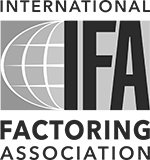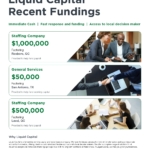Scaling your business with invoice factoring
When you’re scaling your business, invoice factoring should be part of your growth plan.

Cash flow. It’s often referred to as the “lifeblood” of a business, and for good reason. While most businesses can operate for a period of time with slow sales or little-to-no profits, their days are usually numbered if cash runs out or there is an inconsistent flow of working capital.
However, often businesses will find themselves needing to regularly inject their cash flow with extra working capital — and it’s not because they’re failing to produce sales. In many industries, it’s common to have longer payment terms or they may be scaling their business at such a rate that their current financing is sufficient.
“Positive cash flow in my industry has always been extremely important because it eliminates unwanted stress that can come with staffing and managing the day-to-day operations. Having a reliable cash flow allows me to focus my attention on growth opportunities.”
Dave Kip, CEO of Best Broadcast
When faced with this situation, many businesses will offer early payment discounts, which ultimately leads to fewer profits — something no business wants to see happen.
So how can businesses make sure they’re able to maintain a positive cash flow without offering early payment discounts? And what tools should be in your funding toolkit so you’re ready when a growth opportunity presents itself?
Stop offering early payment discounts
While many may think of invoice factoring as a last resort for companies who don’t qualify for (or can’t secure) traditional funding, it’s actually a smart strategic solution that can be used ongoing. For those that make it part of their company’s overall financial strategy, it can help ensure that the business never has to face a critical cash flow shortfall. This is especially critical for businesses that operate within a seasonal sales model or those that work with clients that have extended payment terms (such as 45 to 60 days or longer).
And when you compare the expense of factoring to the cost of offering early payment discounts, it can become clear that invoice factoring is a cost-saving tool.
For example, some businesses offer prompt pay discounts of between 5 and 10 percent of the invoice total if customers pay their bills in less than 30 days. In tight-margin industries, this can be the difference between profit and loss. The cost of factoring is usually lower.
How invoice factoring works
With invoice factoring, a finance company (or factor) will purchase a business’s outstanding accounts receivable, or invoices. The factor advances the business a percentage of the value of the receivables at the time of purchase — usually between 70 and 90 percent. It then releases the balance, less the factoring fee, when the invoices are collected.
Fast-growth companies tend to be good candidates for invoice factoring because this growth can adversely impact their financial ratios, which makes them unattractive to traditional lenders like banks.
The same goes for startup businesses that don’t yet have enough operating history to qualify for a traditional bank loan. Invoice factoring is relatively common in the trucking, manufacturing, staffing and other service industries — but can be a useful tool or almost any size company in any industry.
Invoice factoring isn’t a last resort

At Liquid Capital, it’s not uncommon for us to help businesses who are on an upward trajectory and need to unlock extra working capital to take things to the next level. And if you’re scaling your business, establishing a relationship with a commercial factor before you’re faced with a cash crunch, will allow you to access capital whenever — and for whatever — is needed.
Recently, we worked with one business owner who faced this exact problem.
While business was booming for Best Broadcast, having a positive cash flow became increasingly important for the company to continue growing. Because the company invoices on net 45-day terms, incoming cash flow can slow down. That means they can be waiting for a minimum of 60 days from when they start a job to get paid (which can cause a significant barrier for growth). To increase their working capital, Best Broadcast resorted to offering early payment discounts, which proved to be a costly solution.
“If a company is offering early payment discounts, factoring is a cheaper option to gain access to money.”
Dave Kip, CEO of Best Broadcast
Every day we’re helping business owners (and finance professionals who work with business owners) to grow and reach their goals.




